We use cookies to make your experience better. Read more
Sweet Peas To Sow or Not to Sow

We must give thanks to Sicilian monk, Franciscus Cupani, who on his wanderings in the Sicilian hillsides in the 17th Century came across wild sweet peas and sent seeds to England. Thus began our love affair with these enchanting flowers which have found their way into our hearts, our gardens and also our homes on pottery and on fabrics. Shakespeare named a fairy after them in A Midsummer Night’s Dream and Keats wrote a poem about them so there is really no getting away from sweet peas.
For our founder Rosebie Morton, it’s the dream of sweet peas that helps to keep her spirits high through the dark months of winter. She has loved Sweet Peas since childhood and always says that if you have room for a pot then you can grow Sweet Peas.
Rosebie grew up in a military family that was constantly moving from place to place, but wherever they lived, her mother Elspeth would create a garden where scented roses, English flowers and herbs would flourish, even in the most unlikely conditions. Sweet peas would always feature in the gardens Elspeth planted and dreams of the first sweet peas of spring have always lived with Rosebie through the dark winter months. “As soon as the first shoots appear and the tendrils beckon, one’s nose starts twitching for that first whiff of exquisite fragrance,” she says.
Over the decades since she founded The Real Flower Company, Rosebie has refined her knowledge of growing this delicate, fragrant flower to a fine art, and today we tend around a million sweet peas a year on our farm just off the South Coast. We asked our Instagram and Facebook followers for their questions on how to grow this quintessential English bloom – and below Rosebie brings her expertise to answer your questions.
Can anyone grow sweet peas?
Have you tried to grow Sweet Peas before but found they did not grow as well as you had hoped, or perhaps this is your first year? They can be as picky and exacting as prima donnas but if you give them all the care and attention that a true prima donna requires then all should be well. Our founder and flower farmer Rosebie Morton has been growing Sweet Peas on our specialist Sweet Pea nursery for more than twenty years. Here she shares her tips to get you started.
What you will need:
- Sweet Pea Seeds
- Loo rolls and a larger pot or root trainers
- Good quality peat free compost
- Water
- Tray or table that you don’t mind getting a bit messy
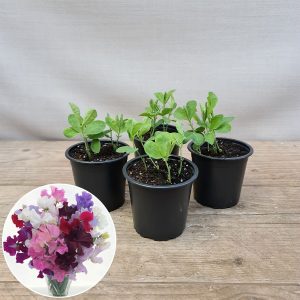
How much space do I need to grow Sweet Peas?
Rosebie always says that if you have space for a pot then you can grow Sweet Peas. If you are growing in a pot then choose one that is at least 40cm in diameter and 40cm in depth. If you are growing in a flower bed then place your plants about 20-30cm apart. Our Sweet Pea seedling pots are designed to be planted in clusters so they can go straight in the ground or into a pot without dividing them.
When is the best time to sow my Sweet Peas?
If you are able to sow seeds in the autumn you are likely to get earlier flowers and stronger stems but they will need care over the winter in an unheated greenhouse, cold frame or porch which isn’t always possible. Root trainer pots are ideal for establishing deep roots and make easy planting in the spring.
You can sow under cover any time from October right through to April. However, October, November, February and March are best, avoiding mid-winter if you can. If you have space and time to nurture your Sweet Peas then sowing early produces strong, earlier-flowering plants but if you have left it until later then it is still worth giving it a go. Rosebie sowed some for her garden in late April one year and they still flowered.

What is the best way to sow Sweet Peas?
Sweet Peas need a long root run – that means space for their roots to spread out. They do not like root disturbance so Rosebie always recommends sowing the seeds in root trainers or the cardboard centres of loo rolls. Fill the root trainers or loo roll centres with damp peat-free multi-purpose potting compost. Sweet Pea seeds are large and easy to handle. Despite popular belief, Sweet Pea seeds do not need to be soaked.
Push the Sweet Pea seed down about 2-3cm below the surface of the compost.
Leave to germinate on a sunny windowsill or in a greenhouse.
Do not let your seeds dry out. Watering from below is best.
Mice love Sweet Pea seeds so use holly to protect your seeds if needed.
Sweet Peas usually start to sprout in a couple of weeks
For the first time this year we are offering our own Sweet Pea seeds direct from our website. You can shop our Sweet Pea seeds here.
Where is the best place to plant my Sweet Peas?
When it comes to planting, it helps to get any structure you might be using in place and then plant the seedlings around it. Sweet peas are very hungry plants and love lots of manure and good compost dug into the soil before planting to give them a really good start. If you can, choose a reasonably sunny site but they don't need to be in full sun. Contrary to popular belief, sweet peas thrive in cooler conditions.
Should I pinch out or trim off the side shoots?
If you want a bush crop don’t pinch out the side shoots, just let them ramble up teepees leaving the tendrils but beware this will result in a beautiful jungle and lots of short sweet peas. If you are growing Sweet Peas for picking and want long straight stems then trim off the side shoots, leaving the central stem. Rosebie loves to use these Snips for taming Sweet Peas.
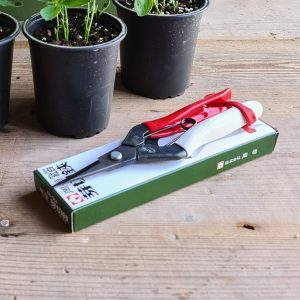
Should I take off the tendrils?
For longer stems pinch out the side shoots and take out the tendrils to avoid the tendrils tangling and producing bendy short stems. Don’t be too hard on yourself though because if there’s a heatwave you’ll probably get shorter stems whatever you do as they don’t like really hot weather. If you want a natural display or are pressed for time then you can just leave the tendrils to develop resulting in very bushy and full plants.
How do I encourage my Sweet Peas to produce more flowers?
Sweet Peas are very hungry so Rosebie recommends planting them in good quality peat free compost and incorporating a handful of slow release fertiliser such as Vitax Q4 to kickstart the plants. As soon as you see the first buds appearing, feed weekly with a liquid feed similar to a tomato feed, i.e. high in potassium. Even more important is to prevent your Sweet Peas from going to seed during the flowering season, so make sure you keep deadheading or picking the flowers.
How often should I water my Sweet Peas?
When your Sweet Peas are still seedlings it is important not to let them dry out, so keep the compost moist. Rosebie suggests watering your pots from below by placing them in a tray of water for a while until they feel heavier and the compost on the top looks moist but not waterlogged.
When you plant out your Sweet Peas you will also need to water them regularly. Rosebie suggests giving them a good water every few days (depending on how hot and dry it is) rather than a light drizzle more regularly.
How should I protect my Sweet Peas from slugs?
If you find that slugs are enjoying your Sweet Peas then Rosebie suggests trying copper bands, beer traps or the biological control Nemaslug.
As a final note, it is not cheating to buy Sweet Pea seedlings or plug plants! It can take a lot of the hassle out of growing Sweet Peas and reward you with lots of beautiful blooms this summer.
Varieties are key which is why we breed our own for stem length and scent. Buy seed according to your requirements and take it from there.
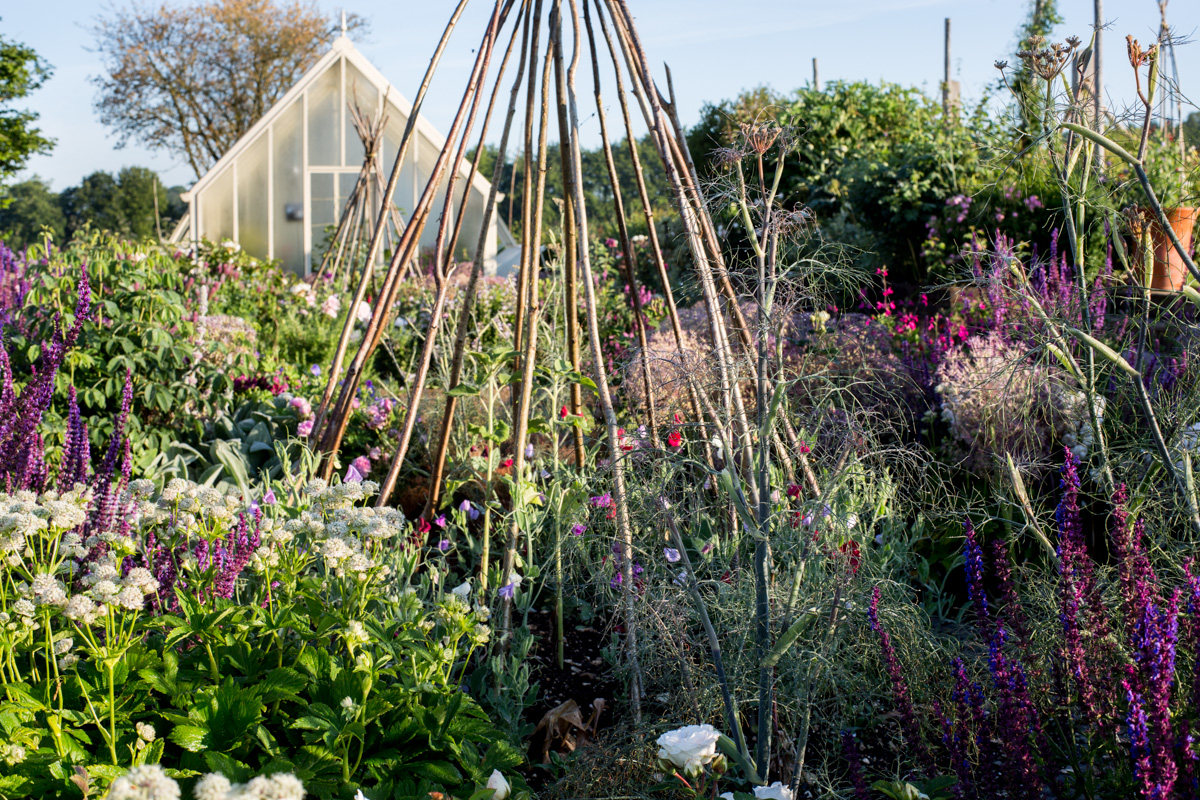
When to Sow Sweet Peas for Cut Flowers
February - March is the perfect time to sow Sweet Pea seeds but Rosebie has sown Sweet Peas as late as April and still been successful. One of the things that is so magical about sowing Sweet Pea seeds during the dark winter is the promise of what is to come, when the exquisite scent of the first Sweet Pea flowers of the year unfurl.
The Best Varieties of Sweet Peas to Grow for Cut Flowers
If you are growing Sweet Peas outside in the UK Rosebie recommends choosing a summer flowering variety. For the very first time this year you can order Sweet Pea seeds directly from our specialist Sweet Pea nursery. If you are growing Sweet Peas for cut flowers then we would recommend our very own sweet pea mix. This mix has been carefully cultivated and trialed for years by the team to produce an abundance of flowers, filled with scent and longer stem lengths which are perfect for flower arranging and are of a quality to win at local flower shows. By popular demand we also have a limited number of packets of Theresa Maureen seeds. Theresa Maureen is perfect for pots and smaller gardens - it is strong and reliable and has beautifully shaped white flowers with lilac tips and an exquisite scent.
Perfect Pots
One of the key things when growing Sweet Peas from seed is to make sure the roots have enough depth (known as the root run). Sweet Peas do not like to have their roots disturbed so Rosebie suggests using loo-rolls kept upright in a group or invest in ‘Root Trainers’ which cleverly hinge open.
Where to Grow
Rosebie always suggests getting Sweet Pea seeds started on a sunny windowsill or in a greenhouse, rather than sowing directly into the soil.
How to Plant
- Start by moistening your compost - use a big tray or garden table and mix the compost with water so it’s damp but not soaking.
- If you are using loo-rolls place them in a larger pot so they stand upright. Then fill your loo rolls or root trainers with the damp compost until about 2-3cm from the top.
- Add your seeds and then cover with a final 2-3cm of compost.
There’s no need to chit or soak your Sweet Pea seeds.
Tip: Mice tend to be keen on Sweet Pea seeds so if your greenhouse attracts mice place some holy leaves over the top.
Caring for Your Sweet Pea Seedlings
Water your pots regularly, to keep the soil moist but never wet. Don’t let the soil dry out.
You can expect to see seedlings appear in about two weeks.
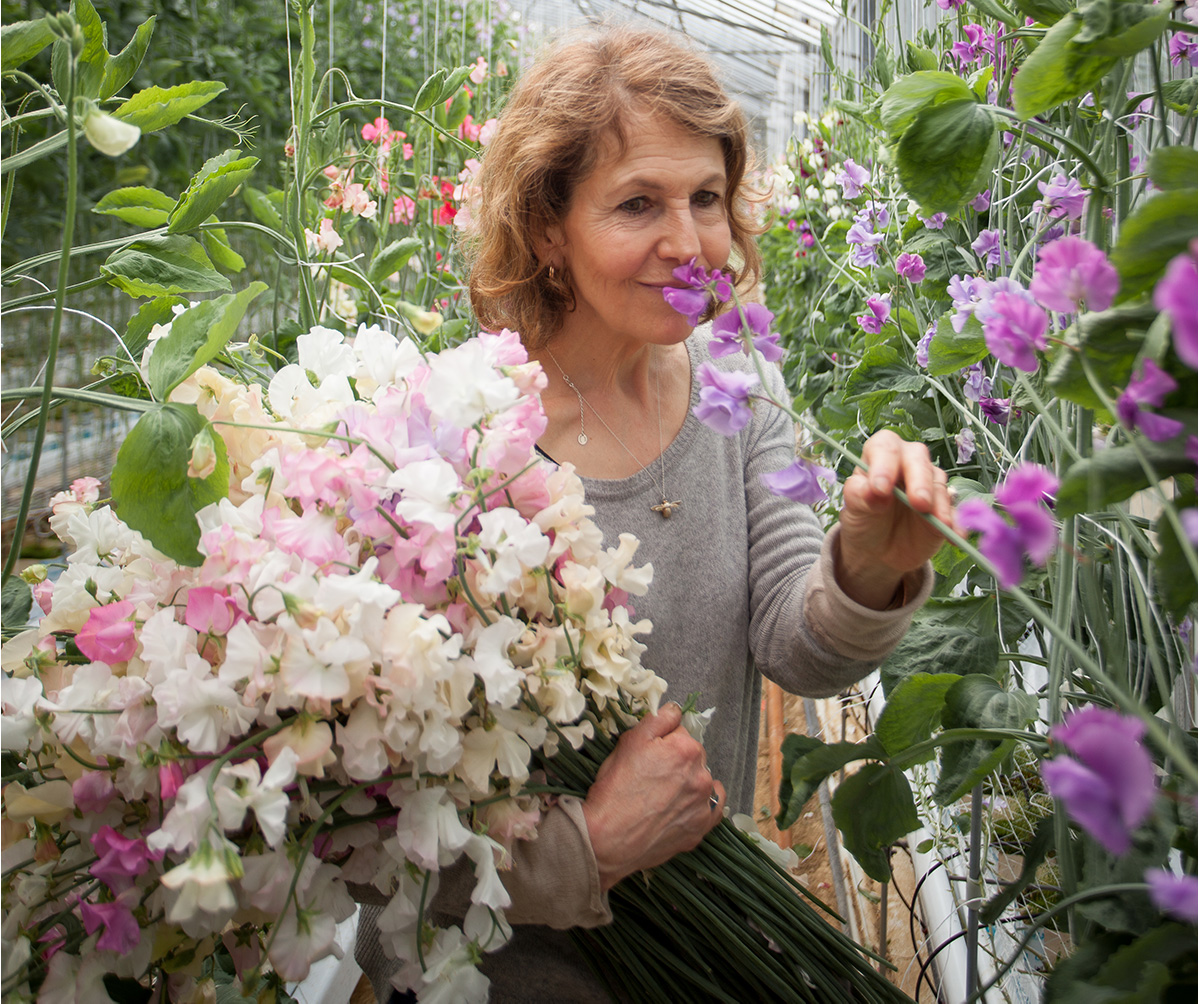
Our founder Rosebie Morton and our small dedicated team have been growing Sweet Peas in our specialist Sweet Pea nursery in West Sussex for more than twenty-five years. It is always such a special milestone in our year when we cut the first Sweet Peas ready to include in our bouquets and Sweet Pea stem boxes. Their heady scent fills the workshop as we fulfil the flurry of orders from Sweet Pea fans across the country eagerly awaiting a box of these quintessentially English blooms to arrive on their doorstep.
Shop Sweet Pea Bouquets & Stem Boxes
You can order pots of Sweet Pea seedlings from our farm, each of them hand-tended by our team and ready to plant out. We have two collections available:
Our Bouquet Mixture has twenty mixed seedlings and come from our own sweet peas grown near Chichester. Lauded for their heady scent, abundance of flowers and long stems, this collection is recommend for a large pot or sunny flower bed.
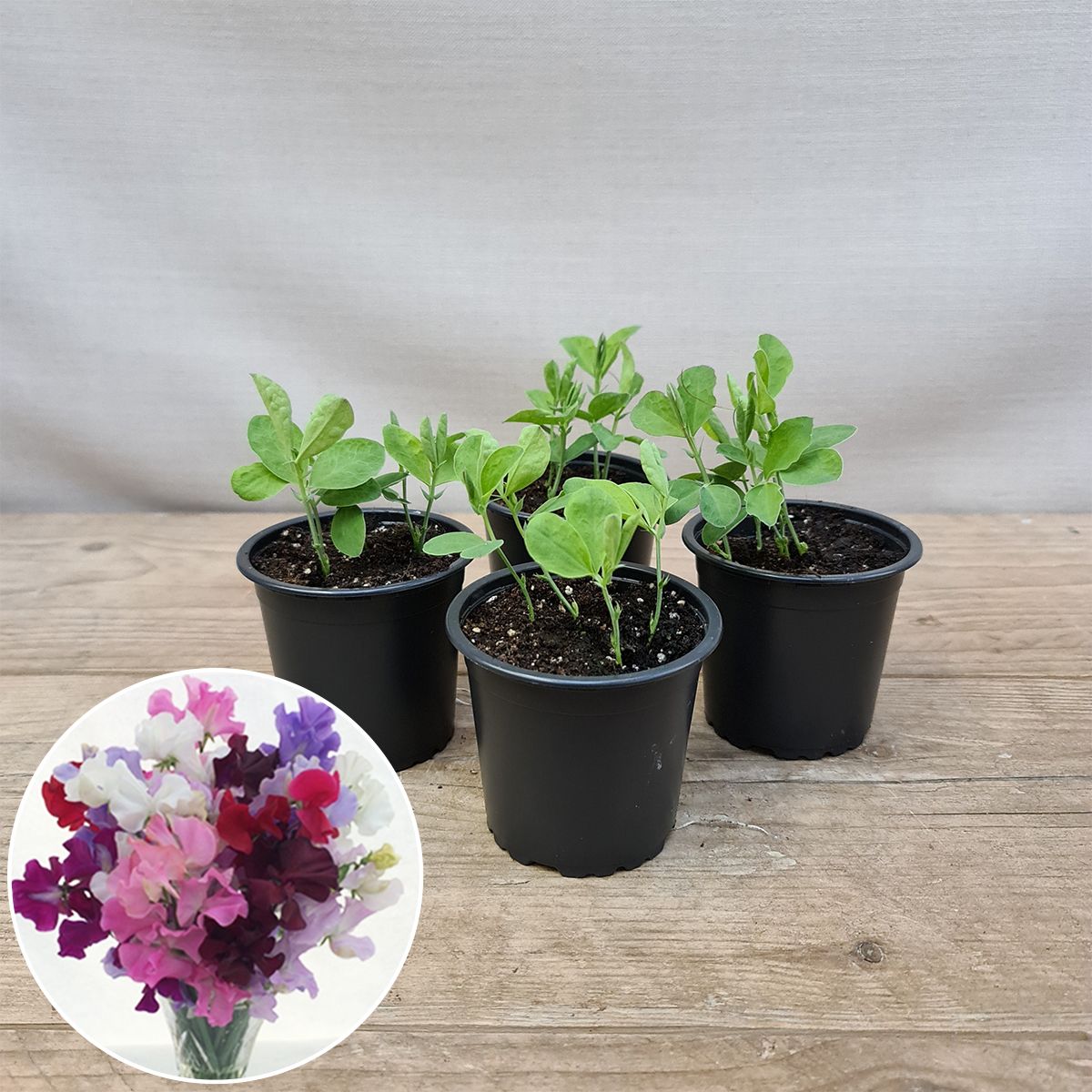
For a smaller pot (40cm in diameter and 50cm in height or more), Rosebie recommends our Theresa Maureen Sweet Pea Seedlings, a smaller variety that is perfect for pots and confined spaces. During the summer months these seedlings will bloom to provide you with an abundance of sweetly scented flowers in white with a violet pink blush.
How to Plant Sweet Peas in a Pot
You will need:
- A large pot
- Good-quality peat-free potting compost
- Something to support your Sweet Peas such as pea sticks and string or an obelisk that fits inside your pot
- A good-quality fertiliser such as Vitax Q4
- Sweet pea seedlings
- Watering can
Step OneFill your pot with good-quality potting compost and add your support. If you are using pea sticks then place them around the edge of your pot and tie the tops together with twine.
Step TwoMake a hole in the compost that is about 50 per cent bigger than the pot the seedlings have been grown in and mix in a good handful of fertiliser. Sweet Peas are hungry feeders so this will get them off to a good start.
Step ThreeRemove the seedlings from the pot very gently, being careful not to disturb the roots. Keep each group of seedlings together – do not try to separate them.
Step FourFill in the hole and gently firm down the compost. Water in well.
Water your pot regularly to keep the compost damp (but not soaking). Feed your Sweet Peas every two weeks. Once buds appear, switch to a high-potash feed such as Tomorite.
The Do's and Don'ts of Growing Sweet Peas
Do – Choose a sunny patch with a least six hours of sun a day to grow your Sweet Peas, if you can.
Do – Tie the stems to the support just under the blooms.
Do – Trim off side shoots if you want long stems and don’t if you want a more rambling, natural display.
Do – Keep deadheading and picking your Sweet Peas to promote more growth.
Do – If you want to collect the seeds to use next year, allow the flowers to go to seed in September. Let the pods dry out on the plant until they are the colour of a paper bag then harvest the seeds on a dry day.
Don’t – Let slugs eat plants. Try using copper bands, beer trips or the biological control Nemaslug to ward them off.
Don’t – Let your Sweet Peas dry out. Keep them well watered, especially if you are growing them in pots.
Don’t – Forget to feed your Sweet Peas.
Don’t – Let you Sweet Peas go to seed during their flowering period.
In the Victorian custom of using flowers to send a message, Sweet Peas symbolised bliss, pleasure and leaving after a positive experience. So a bunch of Sweet Peas hand-picked from your garden is a great way to say thank you. Our Sweet Pea stem boxes also make the perfect thank you gift and our Rose & Sweet Pea Jewel Bouquet is a wonderful choice for birthdays.
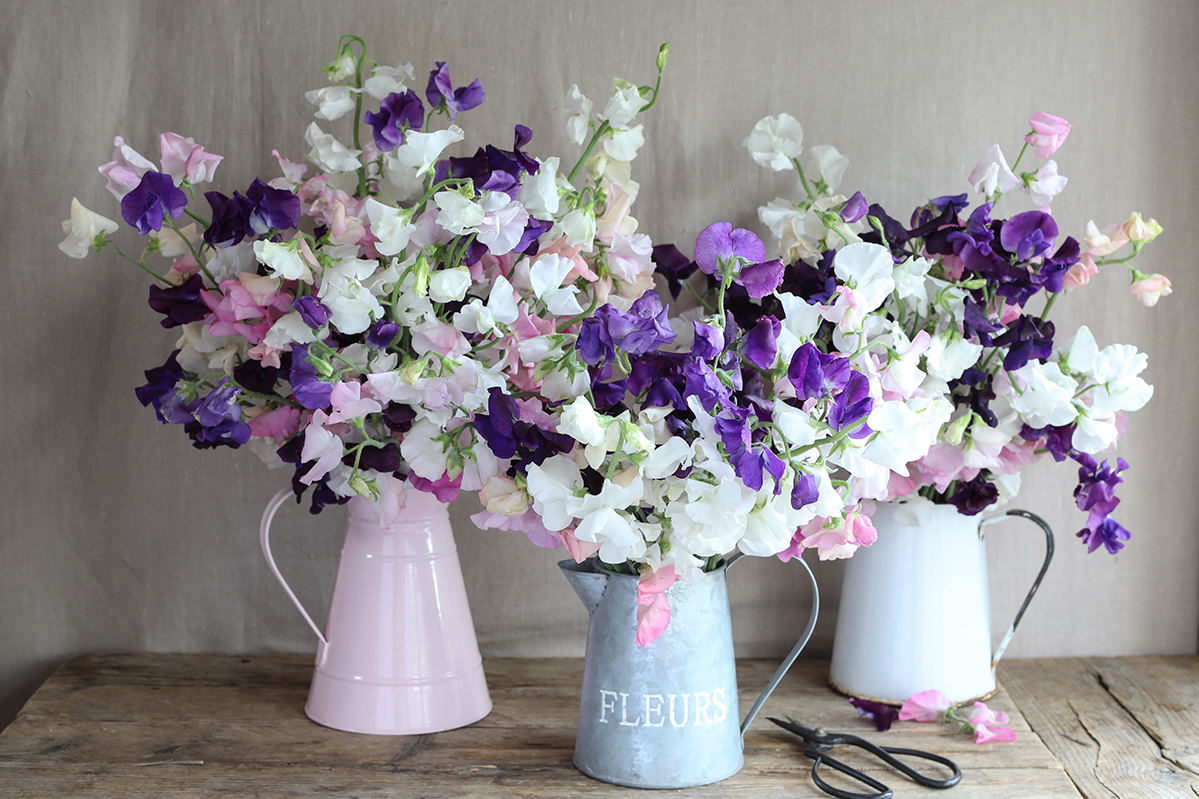
Do you have any tips for producing flowers with long stems to use as cut flowers?
Growing sweet peas with long stems that look gorgeous in our bouquets is one of the areas we have focused on at The Real Flower Company. The choice of variety can to a certain extent dictate the length of stem – for example, the Spencer varieties are naturally longer stemmed. But the other major factor in achieving long stems is to take off the tendrils to avoid them tangling and giving you bendy, twisted short stems.
What should I do if my Sweet Peas grow tall but don't flower?
If your plants aren’t flowering, it could be that they are not getting enough light (they need a minimum of 8 to 10 hours a day, but preferably nearer to 16 hours). If the area where they are planted is too shady, you would do well to move them to somewhere sunny – but make sure you choose a coolish day and water them in well to help them settle. Lack of flowers can also sometimes be a result of too much nitrogen fertiliser, which produces tall, leafy plants but no flowers. To overcome this, feed the sweet peas with either a high phosphorus feed or some bone meal.
I planted my sweet peas out in early April and they just don't seem to be growing - have you any tips?
When your sweet peas are between 4 and 8 inches in height and have approximately four sets of double leaves, just take the growing tip above the top set of the double leaves between your thumb and index finger and use your nail as a blade to remove the growing tip. This will encourage the hormones to produce stronger, bushier growth and more flowers.
I'm growing Sweet Peas on my bedroom windowsill but I'm worried they'll get too soft to plant out. It's the first time I've tried to grow them from seed!
You need to pinch out the tips so they bush out a bit and don’t get too leggy. Then when you see new growth forming, transplant them to their final growing position in full sun. Keep them well watered but not waterlogged and feed them fortnightly with a high phosphorus feed after the first flowers are formed.

Is it better to grow Sweet Peas from seed or to buy plug plants and should you separate the plants within a plug?
Growing from seed gives you more choice of variety, but if you’ve missed the opportunity, plugs can be a great alternative. Don’t separate out the plants – just get them into the ground in a well-prepared site and let them get established.
What should you look for when buying plug plants?
Check that the plants look healthy and are not yellowing. Avoid very leggy and spindly plants or ones that look root bound.
The fabulous fragrance of sweet peas and their delicate form make them the ideal flower to bring the promise of summer into your home. We have a number of spectacular bouquets that feature sweet peas grown on our own English flower farm then hand-tied into glorious arrangements by our expert florists, you can also buy freshly cut English sweet peas in bunches of 25, 50,75 or 100 stems. You can shop our sweet pea collection here.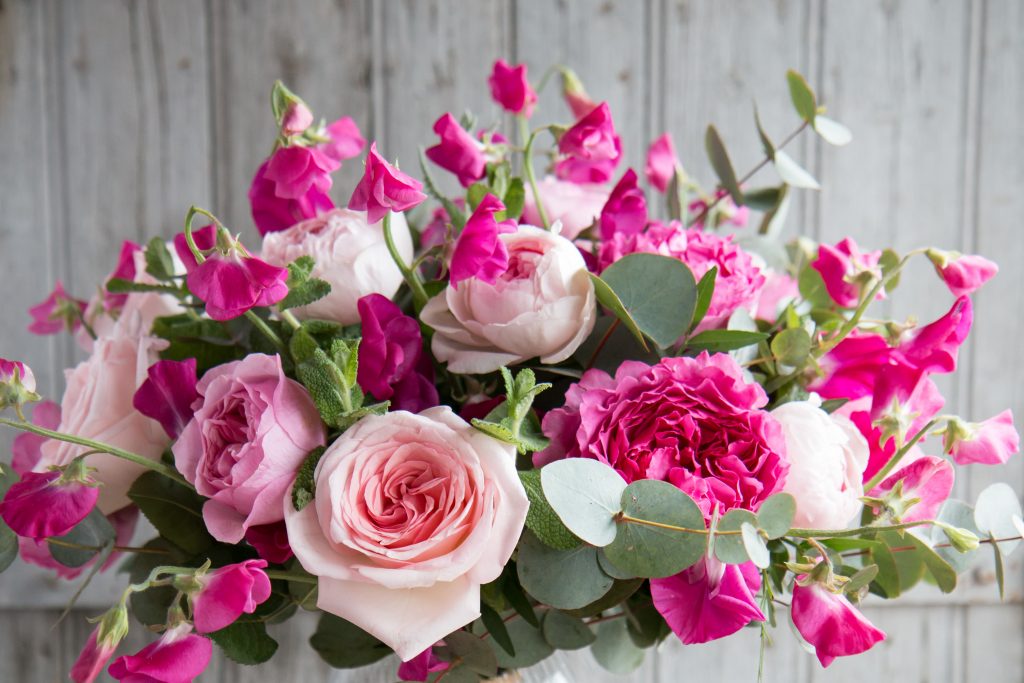 Rosebie Morton, our founder and flower farmer, has loved sweet peas since she was a child. “They are such simple flowers, so understated and yet so beautiful,” she says.
Rosebie Morton, our founder and flower farmer, has loved sweet peas since she was a child. “They are such simple flowers, so understated and yet so beautiful,” she says.
On our sweet pea farm in Chichester, England, we hand-tend around a million sweet peas a year under the watchful care of Rosebie and our farm managers Ewa and Marilia. Our sweet peas are hand-tied into the luxurious scented bouquets that are featured in our sweet pea collection. These can be ordered online for next day London and UK delivery and are also supplied directly to florists. We asked Rosebie for her tips on how to grow sensational sweet peas.
Choosing which sweet peas to grow
If you are growing outdoors in the UK or somewhere with a similar climate I’d always recommend a summer-flowering variety. I think Roger Parsons, who holds the National Collection of Sweet Peas, has a wonderful selection – my favorites are Cathy, Romeo, Zorija Rose, Alisa and Emily.
Tip: Day length is more important than warmth when growing most cut flowers including sweet peas, so choosing a summer-flowering variety is likely to give the best results.
When to sow sweet peas
I’d always suggest sowing inside on a windowsill or in a greenhouse rather than directly into the soil. February to March is the best time to get started but I’ve sown seeds at the end of April and still been successful – I just had a later crop.

How to sow sweet pea seeds
Sweet peas need a good amount of depth for their roots (known as a good root run) and don’t like their roots to be disturbed once they’ve been planted. So I’d suggest sowing your seeds in loo-rolls, kept upright in groups in pots. Or invest in Root Trainers, which cleverly hinge open.
Always use a good-quality compost.
Cover the seeds with about 2–3cm of compost and water them in well.
Water regularly to keep the soil moist but never wet. Don’t let the soil dry out.
Expect your seedlings to start to appear after about two weeks.
There’s no need to chit or soak sweet pea seeds
Tip: If your greenhouse attracts mice, place holly over your pots to act as a natural deterrent. Mice tend to be very keen on sweet pea seeds!
Should you pinch out your sweet peas?
If you are growing your sweet peas for cutting, then when the shoots first appear you will get better results if you establish which is the dominant shoot and pinch out the other, subordinate shoots. Continue to do this as your seedling grows. If you are growing for cutting then also pinch out any tendrils.
If you want a fuller plant for your garden, there’s not need to pinch out.

When to plant out your sweet peas
Plant out your sweet peas when the risk of the last frost has passed, usually in May.
Planting out your sweet peas
Sweet peas are very hungry, so make sure you prepare the soil well with good compost and muck, digging in at least 30cm down.
While planting be careful not to disturb the roots. If you’ve used loo-roll tubes, these can go straight into the ground along with the seed.
Water in well.
Tip: Sweet peas can do well in containers but make sure you choose one that’s 20 litres or bigger.

Supporting your sweet peas
Your sweet peas will need some kind of support. If you are growing sweet peas for the garden, they can look wonderful grown through a tall rose. They also work well up growing up a trellis.
I make teepee shapes using hazel sticks but bamboo from a garden centre works well too.
Tie your sweet peas on to the support as they grow.
How to make your sweet peas last
When your sweet peas first start to bloom, make sure you cut the flowers regularly (or just deadhead regularly if you’ve planted them to enjoy in the garden). Don’t let them go to seed.
Feed your sweet peas again half way through the summer.
Tip: For longer stems, continue to pinch out the tendrils throughout the growing season.

Discover ten sweet-smelling facts about sweet peas here.
You can also shop our range of sweet pea bouquets here.
If you are a florist and are interested in finding out more about our sweet peas, then please get in touch with Suzy and Jilly in our trade team on 01730 818300 or at [email protected].

1. Unique to Us
Sweet peas (Lathyrus odoratus) derive their name from the Greek lathyros for pea or pulse, and the Latin odoratus, meaning fragrant. The types of sweet pea we grow in our English flower farm are exclusive to us – we’ve carefully cultivated them from our own seed over the last 28 years.
2. Smell as Sweet
Sweet peas are native to Sicily, Cyprus and Southern Italy. A Sicilian monk is said to have sent the first sweet pea seeds to England in the 17th century and they became popular in the late-Victorian era after being cultivated by Henry Eckford.

3. Quintessentially English
As well as their flowers and scent, our sweet peas are known for their long, straight stems. This is in part thanks to the climate of our flower farm near Chichester in West Sussex, where the cool, sunny conditions allow the plants to grow slowly, producing their elegant, long stems.
4. Sweet Pea Care
Growing your own sweet peas this year? Our founder and leading horticulturalist Rosebie Morton’s top tip is to take time to prepare your soil. Use a good-quality organic fertiliser and ensure you plant your seeds deep enough (see packet for details). Greedy sweet peas need to be fed and watered frequently. For long stems, trim off side shoots and tie a support just under the blooms.
5. Peas in a Pod
Rosebie has travelled afar in search of the best new varieties. In Japan large flowers are prized while Australia produces some wonderfully frilly blooms. We’re always trialling new varieties that we look forward to sharing with you.
6. British Grown Wedding Flowers
Many years ago our (then) head florist got married in May, surrounded by sweet peas –the perfect choice for an English country wedding. We use the finest-quality scented sweet peas from our English flower farm at weddings and events all over the country. We can also supply DIY wedding flowers direct from our Hampshire and West Sussex farms. You can find out more here on our website on the Wedding & Events section.

7. Keep Sweet
Sweet peas are known to be long-lasting. Over the past quarter century we’ve perfected our varieties and growing techniques to ensure that the blooms from our sweet pea flower farm in West Sussex have an exceptional vase life.
8. Cut Stem Care
To ensure your cut sweet pea stems last as long as possible, change the water regularly. Either use flower food or a spoon of sugar, a spoon of vinegar and a dash of bleach to keep your flowers fresh and blooming.
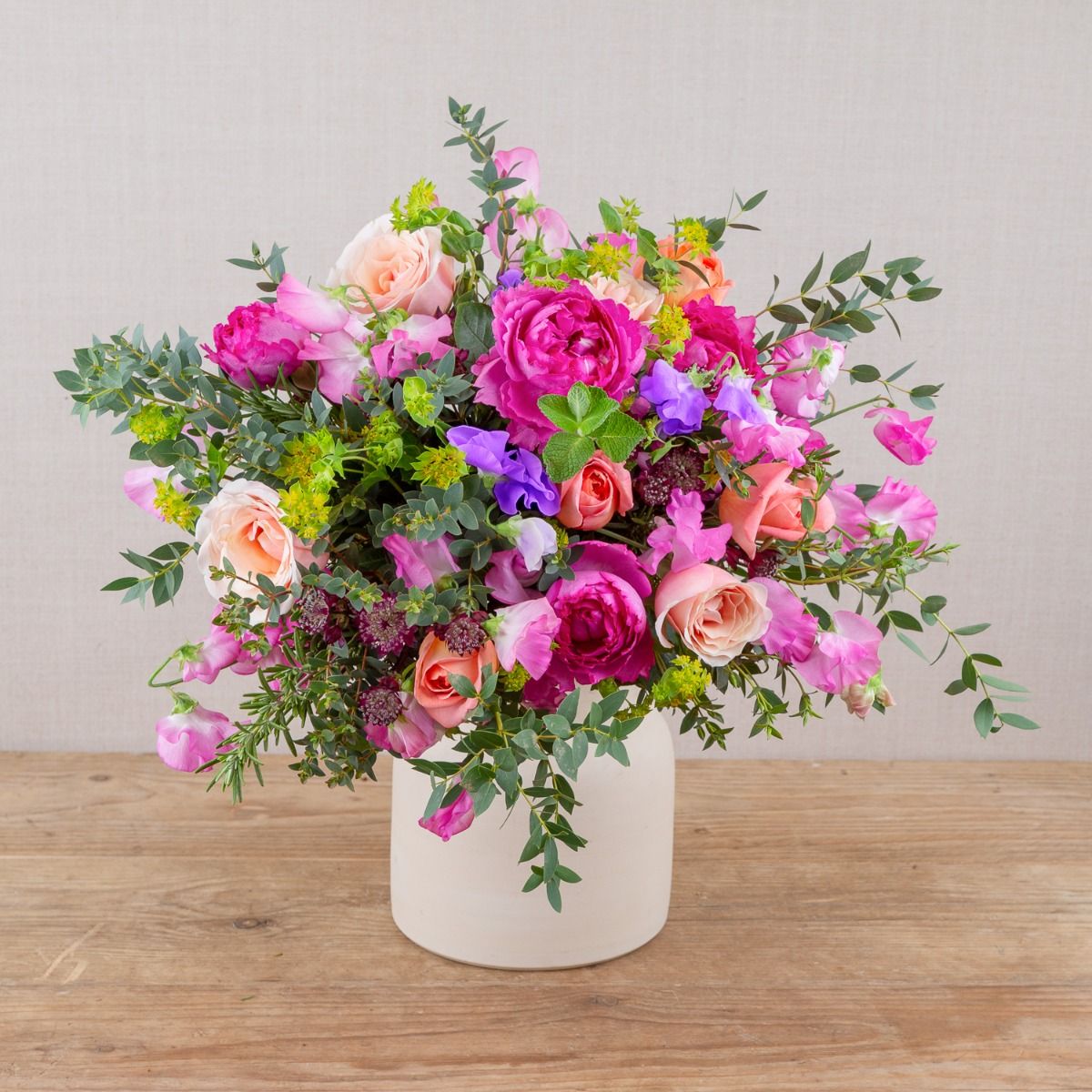
9. More Than a Pretty Bloom
Sweet peas are a member of the legume family – so the flowers can help improve the quality of your soil by increasing its nitrogen content.
10. The Meaning of Sweet Peas
In the language of flowers (sometimes called floriography), sweet peas symbolise bliss, pleasure and leaving after a positive experience. So sweet peas are a great way to say thank you. Our Cream & Ivory Bouquet makes the perfect thank you gift and our Rose and Sweet Pea Jewel Bouquet is a wonderful choice for birthdays.


